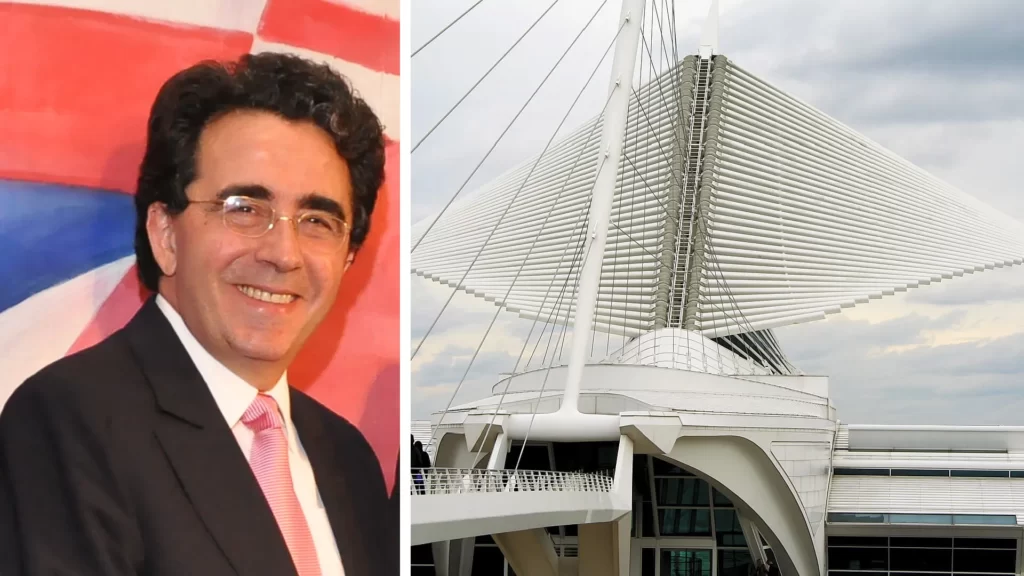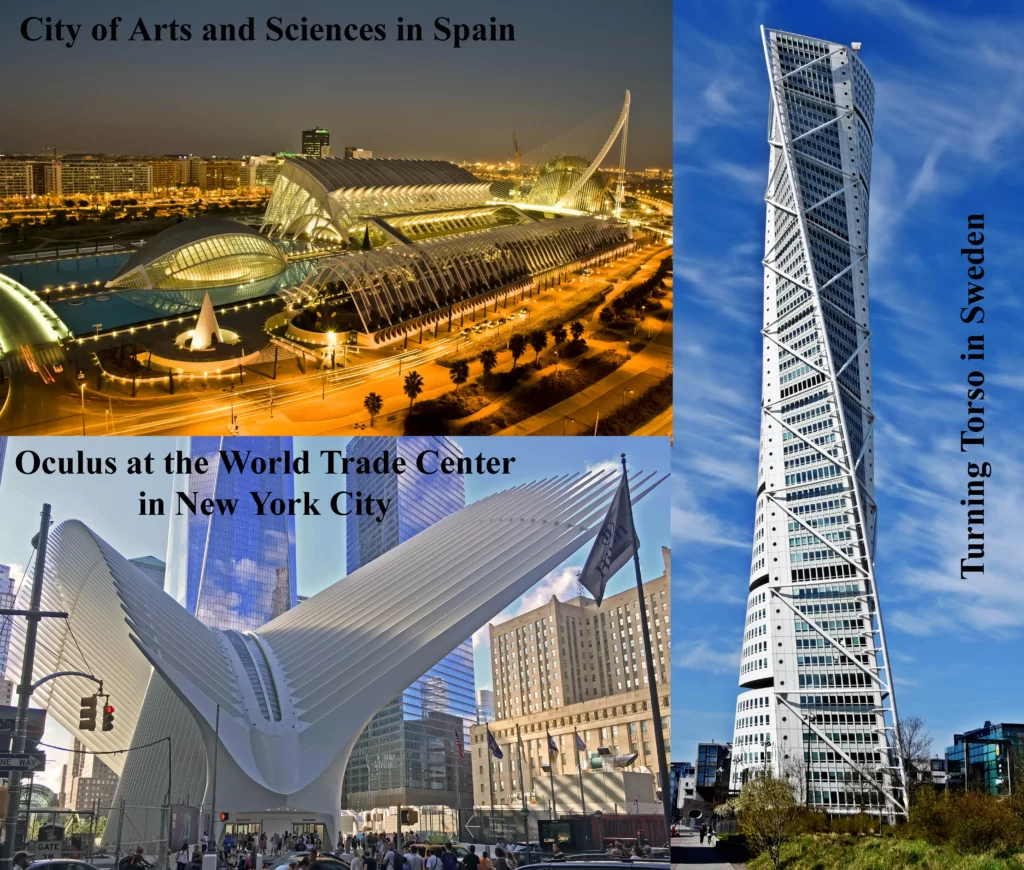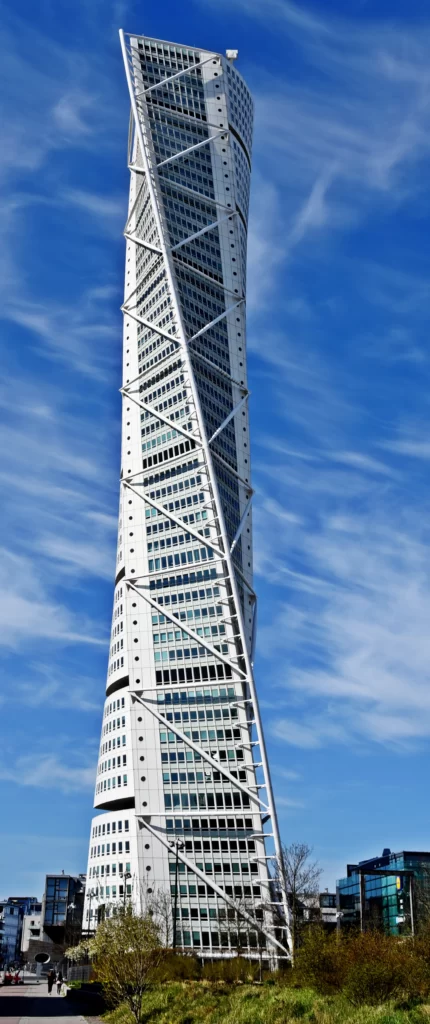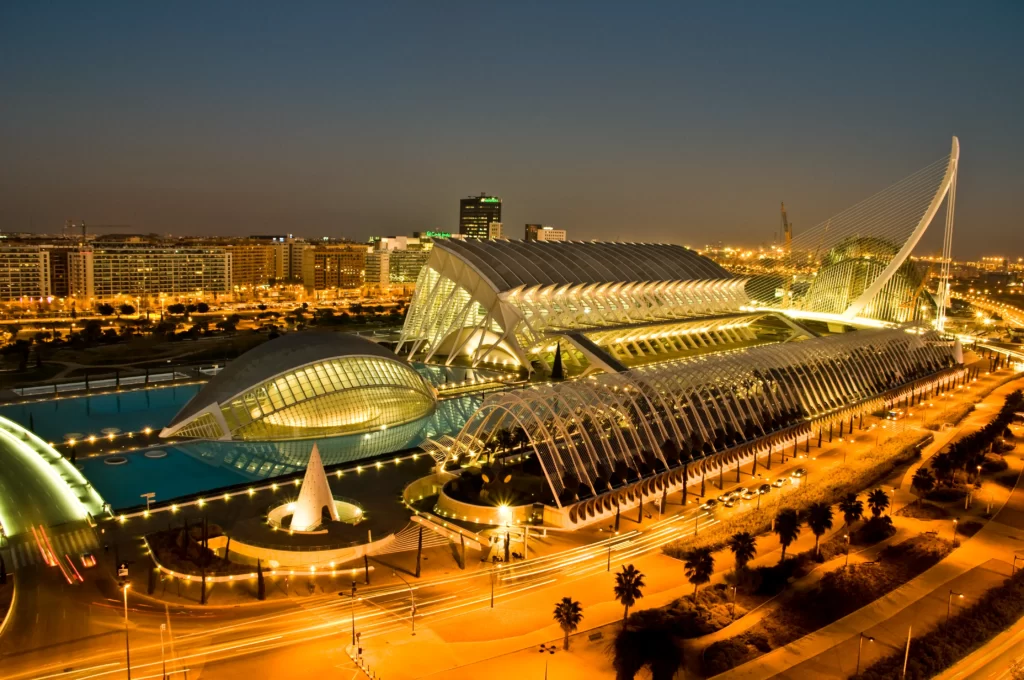If you want to know about the laurie baker or norman foster or staircase design, please click the link.
Introduction
Santiago Calatrava is a Spanish architect, engineer, and artist who is known for his unique and innovative designs that blend art, engineering, and nature.

He has designed many notable buildings and structures around the world, including the Turning Torso in Sweden, the City of Arts and Sciences in Spain, and the Oculus at the World Trade Center in New York City. Calatrava is widely recognized for his distinctive style and his ability to create buildings and structures that are both functional and aesthetically pleasing.

Santiago Calatrava’s contributions to architecture have had a significant impact on the field, both in terms of his unique style and his innovative use of materials and techniques.
His buildings and structures are not only functional, but also visually stunning, and they have inspired a new generation of architects to explore the intersection of art, engineering, and nature.
Through his work, Calatrava has helped to push the boundaries of what is possible in architecture and has left a lasting legacy that will continue to inspire and influence future generations of designers.
1) Early Life and Education
Santiago Calatrava was born on July 28, 1951, in Valencia, Spain. His father was a chemical engineer, and his mother was a homemaker.
Calatrava grew up in a family that valued both the arts and sciences, and this influenced his early interest in both engineering and architecture. He began drawing and painting at a young age, and he also showed an aptitude for mathematics and science.
Calatrava attended the Polytechnic University of Valencia, where he earned a degree in architecture in 1974. During his time there, he was heavily influenced by the works of architects such as Le Corbusier and Louis Kahn, as well as by artists like Joan Miró and Alexander Calder. He also became interested in the intersection of art and engineering, and he began to experiment with incorporating both disciplines into his designs.
After graduating from the Polytechnic University of Valencia, Calatrava went on to study engineering at the Federal Institute of Technology in Zurich, Switzerland. There, he was exposed to the work of Swiss engineer Robert Maillart, who had a significant influence on his designs.
Calatrava also became interested in the use of steel and concrete as building materials, which would become a hallmark of his later work.
2) Architectural Style and Techniques
Santiago Calatrava’s architectural style is characterized by a fusion of art, engineering, and nature. His designs often incorporate fluid, organic shapes that are inspired by natural forms such as birds, fish, and plants. He is also known for his use of light, which he often employs to create dramatic effects within his buildings.
One of the defining features of Calatrava’s style is his use of tension and compression to create structures that appear to defy gravity. He often employs cantilevered structures, arches, and cable-stayed systems to create buildings and bridges that are both aesthetically pleasing and structurally sound. Another key aspect of his style is his use of white as a dominant color, which he believes highlights the purity and simplicity of his designs.
Santiago Calatrava commonly uses a variety of techniques and materials in his designs. Some of the materials he uses most frequently include steel, glass, and concrete. He is also known for his use of lightweight materials such as titanium and fiberglass, which allow for greater flexibility and fluidity in his designs.
In terms of techniques, Calatrava often employs advanced computer modeling and simulation tools to design and analyze his structures. He is also known for his use of parametric design, which allows for the creation of complex, non-repetitive shapes and forms. In addition, he often uses sustainable design principles in his work, such as incorporating natural ventilation and daylighting to reduce energy consumption.
3) Design Philosophy
Santiago Calatrava’s design philosophy is heavily influenced by his belief that architecture and engineering should work in harmony with nature. He sees his work as a continuation of the great tradition of engineering and architecture that has been passed down through the ages, and he strives to create designs that are both functional and beautiful.
One of the key principles that guides Calatrava’s work is the idea of unity. He sees his buildings and structures as organic entities that are integrated into their surroundings and the natural environment. He also believes that architecture should be responsive to the needs of its users, and he places a strong emphasis on user-centered design.
Another important aspect of Calatrava’s design philosophy is the idea of innovation. He is constantly exploring new materials and techniques, and he is not afraid to take risks and push the boundaries of what is possible. He also believes that architecture should be a collaborative process, and he works closely with his team of engineers, designers, and contractors to bring his designs to life.
Finally, Calatrava is committed to creating buildings and structures that are sustainable and environmentally friendly. He is a strong advocate for the use of renewable energy sources, and he incorporates features such as green roofs, rainwater harvesting, and natural ventilation into his designs to reduce energy consumption and minimize the impact on the environment.
4) Major Works
Santiago Calatrava has designed a number of iconic buildings and structures around the world. Here are some of his most famous works and a brief overview of each:
The Turning Torso (Malmo, Sweden):

Completed in 2005, the Turning Torso is a residential tower that twists 90 degrees from bottom to top. It is 190 meters tall and is made up of nine cubes, each of which is rotated slightly to create the twisting effect.
The tower is covered in aluminum panels that reflect the changing light and weather conditions, and it is widely regarded as a masterpiece of engineering and design.
The City of Arts and Sciences (Valencia, Spain):

Completed in 2005, the City of Arts and Sciences is a complex of buildings that includes a science museum, an opera house, a planetarium, and an aquarium.
The buildings are connected by a series of bridges and walkways, and they are characterized by their striking, futuristic designs. The complex has become a symbol of Valencia and has helped to revitalize the city’s waterfront area.
The Oculus (New York City, United States):

Completed in 2016, the Oculus is a transportation hub and shopping center that serves as the centerpiece of the rebuilt World Trade Center site.
The building is shaped like a bird taking flight and is made up of a series of steel ribs that support a translucent roof. The interior is filled with natural light and features a central atrium that is meant to evoke a sense of peace and tranquility.
The Milwaukee Art Museum (Milwaukee, United States):

Completed in 2001, the Milwaukee Art Museum is a museum that features a striking, wing-like structure that can be opened and closed to regulate the amount of light entering the building.
The structure is made up of steel and covered in a white membrane, and it has become an iconic symbol of the city.
The TGV Railway Station (Lyon-Saint-Exupéry, France):

Completed in 1994, the TGV Railway Station is a transportation hub that serves as a gateway to the city of Lyon. The station features a dramatic, wing-like roof that spans over 500 meters and is supported by a series of steel arches.
The design is meant to evoke the feeling of flight and movement, and it has been widely praised for its innovation and beauty.
The Peace Bridge (Calgary, Canada):

Completed in 2012, the Peace Bridge is a pedestrian and cycling bridge that spans the Bow River in Calgary. The bridge is made up of a series of white steel tubes that form an undulating, wave-like structure.
The design is meant to reflect the natural environment of the river and the surrounding landscape, and it has become a beloved symbol of the city.
Each of these buildings reflects Calatrava’s unique design aesthetic and his commitment to creating structures that are both functional and beautiful.
They are characterized by their innovative use of materials and techniques, as well as their striking forms and shapes. While some have criticized Calatrava for his tendency to go over budget and his sometimes controversial design choices, his works continue to inspire and captivate people around the world.
5) Awards and Achievements
List of notable awards and achievements:
- Prince of Asturias Award for the Arts (1999)
- Gold Medal of the Institution of Structural Engineers (2005)
- Gold Medal of the American Institute of Architects (2005)
- Praemium Imperiale Award for Architecture (2009)
- National Design Award for Lifetime Achievement (2012)
- The European Prize for Architecture (2015)
Impact on the architectural world and his legacy:
Santiago Calatrava has had a significant impact on the architectural world through his innovative designs and his contributions to the field of engineering.
His buildings and structures have become iconic symbols of the cities and communities in which they are located, and his work has helped to redefine the boundaries of what is possible in architecture and engineering.
Calatrava’s legacy is one of creativity, innovation, and technical excellence. His designs are characterized by their organic shapes, their use of light and space, and their integration with the natural environment.
He has inspired countless architects and designers around the world to push the boundaries of their craft, and his influence can be seen in the work of many of today’s leading architects.
However, Calatrava’s legacy is not without controversy. Some critics have argued that his designs are overly expensive and impractical, and that he places too much emphasis on form over function. Others have criticized his management of construction projects and the cost overruns associated with some of his most high-profile projects.
Despite these criticisms, there is no doubt that Santiago Calatrava has left an indelible mark on the architectural world. His designs have helped to shape the way we think about the built environment, and his legacy will continue to inspire and influence future generations of architects and designers.
6) Controversies and Criticisms
- Budget overruns: Several of Calatrava’s projects, including the World Trade Center Transportation Hub in New York City and the City of Arts and Sciences in Valencia, Spain, have been criticized for going significantly over budget. The transportation hub, for example, was originally projected to cost $2 billion, but ended up costing nearly $4 billion.
- Construction delays: Many of Calatrava’s projects have also been plagued by construction delays, including the World Trade Center Transportation Hub and the Margaret McDermott Bridge in Dallas, Texas. These delays have led to frustration among residents and officials, as well as increased costs for the projects.
- Criticisms of his designs: Some critics have argued that Calatrava’s designs are overly expensive and impractical, and that he places too much emphasis on form over function. Others have criticized his designs for being too similar to each other, and for lacking the cultural and contextual references that are often seen in the work of other architects.
- Safety concerns: Calatrava’s work has also been criticized for safety issues, particularly in the case of the glass panels at the City of Arts and Sciences in Valencia, which have been known to fall and cause injury.
Despite these controversies, there are many who continue to admire Calatrava’s work for its beauty, innovation, and technical excellence. Many of his projects have become beloved landmarks and symbols of their respective cities, and his influence can be seen in the work of many of today’s leading architects.
However, the controversies surrounding his work have also led to important discussions about the role of architects and designers in creating sustainable, practical, and financially responsible buildings and structures.
7) Impact on the Future of Architecture
Santiago Calatrava’s influence on the future of architecture and how his work has inspired other architects and designers:
Calatrava’s influence on the future of architecture:
- Pushing the boundaries of what is possible: Calatrava’s innovative designs and use of cutting-edge technology have helped to push the boundaries of what is possible in architecture and engineering. His work has inspired others to explore new materials, forms, and construction techniques.
- Emphasis on sustainability: Calatrava has been vocal about the importance of sustainability in architecture, and his designs often incorporate sustainable features such as green roofs, solar panels, and natural ventilation systems. His emphasis on sustainability has helped to raise awareness of the importance of designing buildings and structures that are environmentally responsible.
- Integration with the natural environment: Calatrava’s designs often incorporate elements of the natural environment, such as water and light, and his structures are often integrated seamlessly into their surroundings. This emphasis on blending the built environment with the natural world has inspired others to create designs that are more harmonious with their surroundings.
- New approaches to structural engineering: Calatrava’s background in engineering has influenced his approach to architecture, and his designs often incorporate innovative structural solutions that are both functional and visually striking. His work has inspired other architects and engineers to explore new approaches to structural engineering.
Inspiration for other architects and designers:
- Many architects and designers have cited Calatrava’s work as a source of inspiration and influence. His designs have been praised for their beauty, elegance, and technical excellence, and his influence can be seen in the work of many of today’s leading architects.
- Calatrava’s emphasis on sustainability and his integration of the natural environment into his designs have also inspired others to create buildings and structures that are more environmentally responsible and in harmony with their surroundings.
- His innovative use of materials and construction techniques has also inspired other architects and designers to explore new possibilities for building design and construction.
Overall, Santiago Calatrava’s work has had a profound impact on the field of architecture and has inspired countless architects and designers to explore new ideas and approaches. His legacy will continue to shape the future of architecture for years to come.
8) Conclusion
- Santiago Calatrava is a world-renowned architect known for his innovative designs, use of cutting-edge technology, and emphasis on sustainability.
- Calatrava’s unique style is characterized by its organic forms, use of light and water, and incorporation of the natural environment.
- His most famous works include the Turning Torso in Sweden, the City of Arts and Sciences in Spain, and the Oculus transportation hub in New York City.
- Calatrava’s work has been the subject of controversy, with some critics arguing that his designs are impractical and overly expensive, while others have raised concerns about safety issues and construction delays.
- Despite these controversies, Calatrava’s work has had a profound influence on the field of architecture, inspiring new approaches to sustainability, structural engineering, and integration with the natural environment.
Calatrava’s contributions to architecture and his legacy
- Santiago Calatrava’s contributions to the field of architecture are significant and far-reaching, and his influence can be seen in the work of many of today’s leading architects.
- His emphasis on sustainability, integration with the natural environment, and innovative use of materials and construction techniques have helped to push the boundaries of what is possible in architecture and engineering.
- While his work has been the subject of controversy, it has also sparked important discussions about the role of architects and designers in creating sustainable, practical, and financially responsible buildings and structures.
- Overall, Santiago Calatrava’s legacy as an architect and engineer will continue to shape the future of architecture for generations to come.